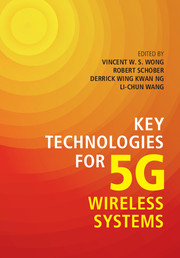Book contents
- Frontmatter
- Contents
- List of Contributors
- Preface
- 1 Overview of New Technologies for 5G Systems
- Part I Communication Network Architectures for 5G Systems
- Part II Physical Layer Communication Techniques
- 6 Non-Orthogonal Multiple Access (NOMA) for 5G Systems
- 7 Flexible Physical Layer Design
- 8 Distributed Massive MIMO in Cellular Networks
- 9 Full-Duplex Protocol Design for 5G Networks
- 10 Millimeter Wave Communications for 5G Networks
- 11 Interference Mitigation Techniques for Wireless Networks
- 12 Physical Layer Caching with Limited Backhaul in 5G Systems
- 13 Cost-Aware Cellular Networks Powered by Smart Grids and Energy Harvesting
- 14 Visible Light Communication in 5G
- Part III Network Protocols, Algorithms, and Design
- Index
- References
10 - Millimeter Wave Communications for 5G Networks
from Part II - Physical Layer Communication Techniques
Published online by Cambridge University Press: 28 April 2017
- Frontmatter
- Contents
- List of Contributors
- Preface
- 1 Overview of New Technologies for 5G Systems
- Part I Communication Network Architectures for 5G Systems
- Part II Physical Layer Communication Techniques
- 6 Non-Orthogonal Multiple Access (NOMA) for 5G Systems
- 7 Flexible Physical Layer Design
- 8 Distributed Massive MIMO in Cellular Networks
- 9 Full-Duplex Protocol Design for 5G Networks
- 10 Millimeter Wave Communications for 5G Networks
- 11 Interference Mitigation Techniques for Wireless Networks
- 12 Physical Layer Caching with Limited Backhaul in 5G Systems
- 13 Cost-Aware Cellular Networks Powered by Smart Grids and Energy Harvesting
- 14 Visible Light Communication in 5G
- Part III Network Protocols, Algorithms, and Design
- Index
- References
Summary
Motivations and Opportunities
Wireless broadband systems, such as cellular and Wi-Fi systems, are now a ubiquitous presence in our lives around the world. Today, these systems operate using carrier frequencies below 6 GHz. The fifth generation (5G) systems must be designed to meet future demands for wireless data, which are projected to continue growing exponentially with time. This has motivated researchers to look at the underutilized bands available at higher frequencies [1–5]. Current research has shown that millimeter wave systems could provide the capacity enhancements needed for serving future wireless data [6–11].
Bands at millimeter wave frequencies, which can roughly be defined as bands with carrier frequencies between 30 and 100 GHz, have received little commercial attention in the past. To meet the demands for new spectrum, the Federal Communications Commission (FCC) has explored the deployment of new services at millimeter wave frequencies [12]. The potential for commercial success of millimeter wave is mainly due to the potential for very large bandwidths. For example, the 60 GHz band, which has received much discussion for potential unlicensed wireless broadband access, has a bandwidth of 7 GHz.
Despite this promise, there are many challenges to be overcome. Communication at millimeter wave frequencies must occur under relatively demanding propagation conditions. High-frequency systems suffer from increased path loss, additional channel losses, and more costly radio frequency (RF) technology [13–17]. Compared with today's systems, the path loss alone can be tens of dB more at millimeter wave frequencies. Luckily, advances in hardware and communication theory are making widespread use of millimeter communication more likely. Device technology has continued to evolve, with advances in the fabrication of complementary metal–oxide–semiconductor (CMOS) compatible millimeter wave radios becoming more and more cost-effective [6, 18]. There have been accompanying advances in RF technology that may make the generation, reception, and analog processing of millimeter wave signals less challenging [8, 9, 19].
Communication researchers have continued to look at multiple-antenna technology, which can be readily employed at millimeter wave. Multiple-antenna radio links in the millimeter wave frequencies are inherently directional, which could enable denser wireless broadband deployments, generating less interference. Research has focused on millimeter wave systems using a multitude of antennas in a small form factor utilizing uniform linear arrays (ULAs) and uniform planar arrays (UPAs).
Information
- Type
- Chapter
- Information
- Key Technologies for 5G Wireless Systems , pp. 188 - 213Publisher: Cambridge University PressPrint publication year: 2017
References
Accessibility standard: Unknown
Why this information is here
This section outlines the accessibility features of this content - including support for screen readers, full keyboard navigation and high-contrast display options. This may not be relevant for you.Accessibility Information
- 2
- Cited by
